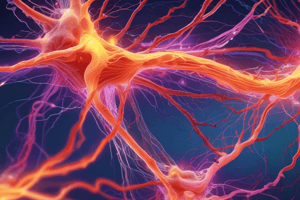Podcast
Questions and Answers
What occurs during the action potential in a neuron?
What occurs during the action potential in a neuron?
What is the resting membrane potential typically around?
What is the resting membrane potential typically around?
What happens to sodium channels after they open during membrane depolarization?
What happens to sodium channels after they open during membrane depolarization?
What characterizes the 'All-or-None Law' in action potentials?
What characterizes the 'All-or-None Law' in action potentials?
Signup and view all the answers
What role does the voltage-gated potassium channel play during an action potential?
What role does the voltage-gated potassium channel play during an action potential?
Signup and view all the answers
When does the inactivation gate of a sodium channel reopen?
When does the inactivation gate of a sodium channel reopen?
Signup and view all the answers
What initiates the generation of an action potential?
What initiates the generation of an action potential?
Signup and view all the answers
How do voltage-gated sodium channels respond to changes in membrane voltage?
How do voltage-gated sodium channels respond to changes in membrane voltage?
Signup and view all the answers
What determines the strength of a stimulus in terms of action potentials?
What determines the strength of a stimulus in terms of action potentials?
Signup and view all the answers
During which period is the axon membrane unable to respond to any subsequent stimuli, regardless of their strength?
During which period is the axon membrane unable to respond to any subsequent stimuli, regardless of their strength?
Signup and view all the answers
What type of stimulus is required to generate a second action potential during the relative refractory period?
What type of stimulus is required to generate a second action potential during the relative refractory period?
Signup and view all the answers
What is the impact of the myelin sheath on the ion flow through the membrane?
What is the impact of the myelin sheath on the ion flow through the membrane?
Signup and view all the answers
Why is saltatory conduction faster in myelinated fibers compared to nonmyelinated fibers?
Why is saltatory conduction faster in myelinated fibers compared to nonmyelinated fibers?
Signup and view all the answers
Where do action potentials occur in myelinated axons?
Where do action potentials occur in myelinated axons?
Signup and view all the answers
How much can the velocity of nerve transmission increase due to saltatory conduction in myelinated fibers?
How much can the velocity of nerve transmission increase due to saltatory conduction in myelinated fibers?
Signup and view all the answers
What characteristic of myelinated axons contributes to less resistance in the spread of charges?
What characteristic of myelinated axons contributes to less resistance in the spread of charges?
Signup and view all the answers
Flashcards
Stimulus strength coding
Stimulus strength coding
The strength of a stimulus is coded by the frequency of action potentials, not their amplitude.
Absolute Refractory Period
Absolute Refractory Period
A period after an action potential where the neuron cannot respond to any stimulus (no matter how strong).
Relative Refractory Period
Relative Refractory Period
A period after an action potential where a stronger-than-usual stimulus is needed to trigger another action potential.
Saltatory Conduction
Saltatory Conduction
Signup and view all the flashcards
Myelin Sheath
Myelin Sheath
Signup and view all the flashcards
Nodes of Ranvier
Nodes of Ranvier
Signup and view all the flashcards
Action Potential Propagation
Action Potential Propagation
Signup and view all the flashcards
Conduction Speed in Myelinated vs. Non-Myelinated Axons
Conduction Speed in Myelinated vs. Non-Myelinated Axons
Signup and view all the flashcards
Action Potential (AP)
Action Potential (AP)
Signup and view all the flashcards
Voltage-Gated Sodium Channel
Voltage-Gated Sodium Channel
Signup and view all the flashcards
Sodium Channel Activation
Sodium Channel Activation
Signup and view all the flashcards
Sodium Channel Inactivation
Sodium Channel Inactivation
Signup and view all the flashcards
Voltage-Gated Potassium Channel
Voltage-Gated Potassium Channel
Signup and view all the flashcards
Threshold
Threshold
Signup and view all the flashcards
All-or-None Law
All-or-None Law
Signup and view all the flashcards
Na+-K+ ATPase
Na+-K+ ATPase
Signup and view all the flashcards
Study Notes
Action Potential Overview
- Action potentials are rapid changes in membrane potential characterized by depolarization and repolarization.
- Action potentials are triggered when the membrane potential reaches a threshold.
- The rapid depolarization phase involves sodium ions entering the cell.
- Repolarization involves potassium ions leaving the cell.
- The after-hyperpolarization phase occurs as potassium channels slowly close.
- An action potential is an 'all-or-none' phenomenon; the size of the response does not vary with the strength of the stimulus.
Voltage-Gated Sodium Channels
- Voltage-gated sodium channels have two gates: activation and inactivation gates.
- Activation gates open rapidly in response to depolarization.
- Inactivation gates close slowly after the activation gate opens.
- Sodium channels become inactivated at a certain membrane potential.
- Channels cannot be opened by depolarization while inactivated.
Voltage-Gated Potassium Channels
- Voltage-gated potassium channels open more slowly than sodium channels in response to depolarization.
- Outward current through open potassium channels repolarizes the membrane.
- Potassium channels close slowly, contributing to the after-hyperpolarization phase.
Refractory Periods
- Absolute refractory period: No stimulus can elicit another action potential, Na+ channels inactivated.
- Relative refractory period: A stronger-than-normal stimulus can elicit an action potential, K+ channels still open.
- The refractory periods help to ensure unidirectional propagation of action potentials.
Action Potential Propagation
- Local currents depolarize adjacent regions, causing voltage-gated sodium channels to open.
- Action potentials propagate along the axon in a chain reaction.
- Myelinated axons have gaps in the myelin sheath, known as Nodes of Ranvier, where voltage-gated sodium channels are concentrated.
- Action potentials jump between nodes, called saltatory conduction, which speeds up propagation compared to unmyelinated axons.
Inhibition of Excitability
- Local anesthetics prevent action potentials by binding to voltage-gated sodium channels.
- This prevents sodium ions from flowing into the cell and inhibits depolarization.
Plateau in Some Action Potentials
- Some action potentials demonstrate a plateau phase, often seen in cardiac muscle.
- This phase involves a mix of voltage-gated calcium and sodium channels, contributing to sustained depolarization.
Rhythmic Activity
- Some tissues exhibit rhythmic activity, creating action potentials repetitively.
- This rhythm is often controlled by specific ion currents and the interactions of voltage-gated ion channels.
Studying That Suits You
Use AI to generate personalized quizzes and flashcards to suit your learning preferences.
Related Documents
Description
This quiz explores the dynamics of action potentials and the roles of voltage-gated sodium and potassium channels. Test your knowledge on the phases of action potentials, the all-or-none principle, and the mechanisms governing sodium and potassium channels. Perfect for students in neurobiology or physiology courses.




